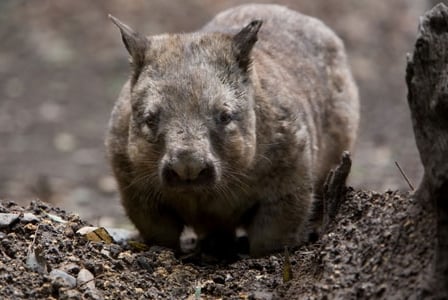
They may look like the roly-poly pigs, but theyre more closely related to koalas. On this Wildlife Wednesday, we dig up some details about northern hairy-nosed wombats.
They may look like the cutest roly-poly pigs that you ever did see, but these marsupials are actually more closely related to the koala—and even then, the two are related only distantly. On this Wildlife Wednesday, we dig up some details about northern hairy-nosed wombats.
Habitat
Like all wombats, northern hairy-nosed wombats call Australia “home.” Specifically, they can be found burrowing under flat grasslands containing native grasses and woodlands containing either acacia or eucalyptus trees.
Trivia
- Northern hairy-nosed wombats are the largest of the three wombat species. They normally weigh about 70 lb (32 kg) and can reach more than 3 ft (1 m) long.
- Avid diggers, these wombats make elaborate burrows—called “warrens”—to call their homes. Warrens can measure more than 295 ft (90 m) in length and may have multiple entrances and exits.
- They also make good neighbours. The warrens, which only vary slightly in temperature each day, are popular resting places for wallabies and other creatures looking for a break from warm weather.
- Like beavers, a wombat’s teeth will grow for its whole life, meaning that even the eldest of wombats have no problem eating for their regular two to six hours each day.
Why are they threatened?
Unlike its cousin the common wombat, these hairy-nosed herbivores don’t freely roam the Australian outback. As a matter of fact, this particular wombat species is found under the IUCN’s “critically endangered” category and is only found in one location in Australia—Epping Forest National Park.
The wombat numbers initially declined due to extensive habitat destruction and competition with domestic livestock such as sheep, cows, and rabbits—especially during time of drought.
Currently, the animals are threatened due to their own diminished numbers and small range, which make them vulnerable to wildfires and other local disasters; predation by dingoes and other carnivores; disease; and an introduced type of grass invading their natural habitat.
However, there has been some good news recently—their population is considered stable, and has slowly been climbing since its all-time low of 40 members, which was reached in the early 80s. This is thanks to the efforts of the Australian government, which has carried out a number of conservation efforts to reduce predation, mitigate the effects that drought might have on the animals, and stop the spread of introduced buffel grass.

